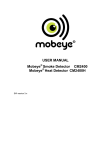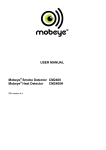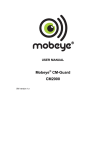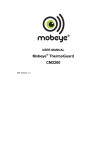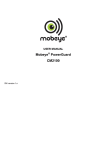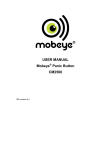Download Mobeye CM2400 User manual
Transcript
USER MANUAL Mobeye® Smoke Detector CM2400 Mobeye® Heat Detector CM2400H SW version 1.n Attention! Very important ® This user manual contains important guidelines for the installation and usage of the Mobeye device as ® described in this manual. Please read these thoroughly before you start using the Mobeye device! Please refer to the he manual of the EI Electronics detector for the instructions regarding the smoke or heat detector. In case of damage caused by disregarding the guidelines, the warranty expires. The user must regularly check the proper functioning of the device. The manufacturer cannot be held liable ® for any damage caused by any incorrect use or incorrect functioning of the Mobeye device. Safety guidelines • The permitted ambient temperature during operation may not be exceeded (not lower than 0°C and not higher than 40°C). • The device is intended for use in dry and clean places. • Protect the device from moisture, heat and water splashing. • The guidelines for the battery usage must be regarded. • Do not expose the device to strong vibrations. • Do not let it fall from height. • Do not use in an environment where any inflammable gases, vapors or dust are present or could be present. ® • The repairs of the device may only be carried out by people trained for Mobeye repair. • In case the device must be repaired, only original replacement components may be used. The use of ® different parts may lead to damage of the Mobeye device. • Please refer to the manual of the EI Electronics detector for the complete safety guidelines. Use in accordance with the regulation The use of the Mobeye GSM module in accordance with the regulation is sending SMS text messages and making telephone calls after an alarm situation. Other usages are not permitted. Battery recycling CR123 batteries, as used in the Mobeye CM2400(H), are classified as non-hazardous waste and can be recycled. Please take empty batteries to a nearest collection point. 1 CONTENT 1. General description 1 Getting started Place a SIM card Place the batteries Enter the program mode Program at least one telephone number Mount the GSM module housing to the ceiling Fix the cover to the GSM module housing Connect the EI detector and close the cover Perform a test 2 2 2 2 2 3 3 3 3 3. Several detectors in a wireless network 4 4. Use of external power supply 5 2. 2.1 2.2 2.3 2.4 2.5 2.6 2.7 2.8 5. Extended options 5.1 Program mode 5.2 The security code 5.3 Programming the settings by SMS 5.4 Possible general settings 5.4.1 Phone numbers 5.4.2 Identification text 5.4.3 Alarm text 5.4.4 Alarm notification type: SMS or SMS + call 5.4.5 Test SMS text message 5.4.6 Power failure SMS message 5.5 List of SMS commands for configuration 5.6 Reset of system 6. 6.1 6.2 6.3 7. Request list of the settings and status Status request List of general settings List of phone numbers 6 6 6 6 7 7 7 7 7 7 7 8 8 9 9 9 9 Technical messages and status feedback 2 10 1. GENERAL DESCRIPTION This manual is applicable for the Mobeye CM2400 and the Mobeye CM2400H. The CM2400 is a battery operated GSM module used to send out an alarm after the input is triggered by the EI Electronics smoke detector EI605TYC. The CM2400H is a battery operated GSM module used to send out an alarm after the input is triggered by the EI Electronics heat detector EI603TYC. In this manual the products are referred to as CM2400(H). The Mobeye CM2400(H) has following behaviour. - - In case the input of the alarm module is activated by the EI Electronics detector, the Mobeye CM2400(H) sends an alarm SMS text message and calls to the phone numbers as programmed by the user. In case the batteries need to be replaced, the Mobeye CM2400(H) sends a ‘battery low’ SMS text message to the administrator. Please refer to the manual of the EI Electronics detector for the description of the behaviour of the smoke or heat detector. 1 2. GETTING STARTED To get started with the Mobeye CM2400(H) at least the following steps need to be taken in following order: 1. 2. 3. 4. 5. 6. 7. 8. Place a SIM card (with PIN code 0000 or without PIN code) Place the batteries Enter the program mode Program at least one telephone number (administrators’ number) Mount the GSM module housing to the ceiling Fix the cover to the GSM module housing Connect the EI Electronics detector and close the cover Perform a test These steps are further explained in this chapter. After these steps the module will be operational. NB: in case several EI detectors form a network communicating by RF, at first the TF modules need to be placed and the detectors need to be enrolled. Please refer to chapter 3. 2.1 PLACE A SIM CARD Insert a SIM card into the GSM module. Push the black cover outward slightly to open the holder. Before installing the SIM card should have PIN code "0000", or be free of a PIN code. (A PIN code can be changed or removed by putting the SIM card in a mobile phone and change or remove the PIN in the security menu.) NB: make sure the SIM card is inserted before the batteries are placed. In case of a SIM card change, please first remove the batteries. 2.2 PLACE THE BATTERIES Place the two batteries (CR123) in the module. Use the +/- indication for the correct placement. The green LED will flash to indicate that the module is not configured (at least one telephone number should be programmed). 2.3 ENTER THE PROGRAM MODE Directly after placing the batteries, the Mobeye CM2400(H) switches to the program mode. First the GSM module establishes network connection. During this time the LED flashes 2 sec. on/1 sec. off. Within 10-30 seconds the connection is established and the status LED starts flashing 1 sec. on/1 sec. off (or ‘on’ in case the first telephone number has been configured). The Mobeye CM2400(H) returns to the program mode by pressing the red on/off button, until the LED starts flashing (or turns to ‘on’). As long as the unit is in the program mode, the status LED is on (or flashing 1 sec. on/1 sec. off if the module has no configuration). During the first 3 minutes, the GSM module remains open, ready to receive SMS commands. After 3 minutes a time-out occurs and the GSM module switches off in order to save the batteries. The unit returns to the low power operational mode. 2.4 PROGRAM AT LEAST ONE TELEPHONE NUMBER The Mobeye CM2400(H) is able to send messages up to 5 telephone numbers. The first telephone number belongs to the administrator. Technical messages (like “battery low”) are sent to the administrator only. Without the administrators’ phone number, the Mobeye CM2400(H) cannot not function. When the CM2400(H) is in initial (factory) status and the batteries are placed (so the LED is flashing), the administrators’ number is programmed by calling the telephone number of the Mobeye CM2400(H) using the administrators’ phone. The unit will recognize this number and store it as administrator (telephone number 1). The administrator will receive a confirmation SMS text message including the security code. This code is needed to program the other settings in the unit. NB: for this way of programming the number recognition in the administrator’s phone must be ‘on’. To program or change the administrators’ number by SMS command, please refer to 5.4.1. 2 2.5 MOUNT THE GSM MODULE HOUSING TO THE CEILING Mount the housing in which the module is fixed to the desired place to the ceiling, using the plugs and screws. Please refer to the manual of the EI Electronics detector for het ideal location. 2.6 FIX THE COVER TO THE GSM MODULE HOUSING Take the back cover of the EI Electronics detector. Screw this part to the housing of the GSM module. A small opening shows the exact place. Lead the green connector through the whole in the back cover. Take care to not jam the wires. 2.7 CONNECT THE EI DETECTOR AND CLOSE THE COVER Press the cabled connector to the pins of the EI Electronics detector. Next to these pins the text 1 2 is written. Hold the EI detector to prevent tension on the wires! Close the EI detector by bringing it close to the back cover at the correct position and turn is gently until it is closed. In the EI detector a red light will flash regularly. 2.8 PERFORM A TEST After the previous steps, the Mobeye CM2400(H) is in use. It is armed (switched on) automatically. The green LED on the GSM module blinks once in 3 seconds, which can only be seen when opening the back cover of the EI detector. In order to execute a test: - Press the TEST & HUSH button of the EI detector during a few seconds. The siren will sound times and the GSM module will establish network connection in order to send the SMS messages and call the contact persons. 3 3. SEVERAL DETECTORS IN A WIRELESS NETWORK Although the Mobeye CM2400(H) can run as stand-alone unit, it is also possible to form a wireless network with several EI detectors. For this purpose each EI Electronics detectors needs to be equipped with an RF module. This module can be integrated in the EI Electronics detector. Before the detectors are operational, the detectors need to enrolled, in order to know each other. The placement of the RF modules in the EI Electronics detectors and the enrolment need to be done before all other steps in chapter 1. Please refer to the EI Electronics manuals for the steps to follow. 4 4. USE OF EXTERNAL POWER SUPPLY Although the Mobeye CM2400(H) is designed to run on batteries, it is possible to use an external power supply. In this mode the module is always in connection with the GSM network and therefore always in program mode. In case the power fails, the batteries take over the functioning and the administrator is informed by an SMS text message. The module continues operating albeit in the low power mode. This means the GSM module switches off and only establishes network connection in case it needs to send out an alarm, test message or battery low alert. Connect the external power adapter (or any other regulated 12VDC power supply) to the power input of the connector (press on the green pins for connecting the wires): + - - V+ (black lead with white stripe) to “+” - Ground (black lead) to “-“ In case an external power supply is used and a power failure occurs, the Mobeye CM2400(H) sends a ‘power failure’ SMS text message to the administrator. In case the power is restored, the Mobeye CM2400(H) sends a ‘power restored’ SMS text message to the administrator. 5 5. EXTENDED OPTIONS To program the Mobeye CM2400(H), the GSM module must have network connection. In case only batteries are used, first switch the unit to the program mode. Next send SMS commands for the configuration. All settings are stored and will be kept in the unit, even in case the power supplies are removed. 5.1 PROGRAM MODE Directly after placing the batteries, the Mobeye CM2400(H) switches to the program mode. First the GSM module establishes network connection. During this time the LED flashes 2 sec. on/1 sec. off. Within 10-30 seconds the connection is established and the status LED starts flashing 1 sec. on/1 sec. off (or ‘on’ in case the first telephone number has been configured). The Mobeye CM2400(H) returns to the program mode by pressing the program button during 1 seconds, until the LED starts flashing (or turns to ‘on’). The red program button is located inside the enclosure and can be reached by opening the smoke detector. As long as the unit is in the program mode, the status LED is on (or flashing 1 sec. on/1 sec. off in case the module has no configuration). During the first 3 minutes the GSM module remains open, ready to receive SMS commands. After 3 minutes a time-out occurs and the GSM module switches off in order to save the batteries. The unit returns to the low power operational mode. In case the unit is connected to an external power supply, the CM2400(H) has network connection all the time and the unit is in program mode all the time. 5.2 THE SECURITY CODE For configuration activities the security code of the Mobeye CM2400(H) must be used. The initial security code is ‘1111’. In this manual this code is referred to as <CODE>. 5.3 PROGRAMMING THE SETTINGS BY SMS The settings are programmed by SMS text messages. - Be sure the CM2400(H) is in program mode (please refer to 5.1). - Send an SMS message with following content: <CODE> <command> - Do not forget the space character between <PIN code> and <command>. - The commands are case sensitive. - Several commands may be combined in one SMS message (with a maximum of 160 characters) by placing a # between the commands. <CODE> <command1>#<command2> ...... #<commandN> The green LED blinks 3 times to indicate the successful configuration. In case of an incorrect command, the LED flashes 5 times. In 5.5 the complete scheme with SMS commands is listed 6 5.4 POSSIBLE GENERAL SETTINGS This paragraph describes the general settings for the CM2400(H). 5.4.1 Phone numbers The Mobeye CM2400(H) is able to send alarm messages up to 5 phone numbers. The first telephone number (TEL1) belongs to the administrator. Only this number receives all system messages. The other phone numbers (including the administrator) only get the alarm messages. To set or change telephone numbers: SMS command 1st telephone number: SMS command 2nd telephone number: .... similar for TEL3...TEL5 <CODE> TEL1:<tel. number> <CODE> TEL2:<tel. number> To delete telephone numbers: SMS command delete 1st telephone number: <CODE> DEL1 .... similar for DEL2...DEL5 In case a foreign number needs to be entered start with + followed by the country code. Example: 1111 TEL1:+44612345678. 5.4.2 Identification text It is possible to add a standard identification text (NAME) to all messages sent out by the Mobeye CM2400(H). The alarm messages are a combination of the name and the alarm text. A user defined identification has a length of maximum 20 characters. The default identification text is ‘Mobeye’. SMS command identification text: <CODE> NAME:<free text> 5.4.3 Alarm text Unique alarm text can be programmed into the Mobeye CM2400(H). The user defined text has a maximum length of 20 characters. Following default texts are programmed: Triggered input <TEXT1>: Fire alarm! SMS commands text 1: <CODE> TEXT1:<free text> 5.4.4 Alarm notification type: SMS or SMS + call As default behaviour, after an activated input the Mobeye CM2400(H) notifies by SMS text message followed by a telephone call (beep signal). The combination of SMS text and the call increases the chance of getting the attention of the contact persons. It is possible to disable the call (OFF), so that only an SMS message will be sent. The default alarm notification type is ON (SMS + call). SMS command alarm notification type: <CODE> CALL:xxx 5.4.5 Test SMS text message The Mobeye CM2400(H) can send regular test SMS messages (´keep alive’) to the administrator, to ensure the proper functioning of the unit. The test message function is only active in case the unit is armed. The interval between the test messages can be set between 0 days (no test message) and 30 days. The default test interval is set to 0 (no test message). SMS command interval test message: <CODE> TEST:xx 5.4.6 Power failure SMS message In case the Mobeye CM2400(H) is powered externally and the power fails it sends an SMS text message to the administrator. The message is only sent in case the unit is armed. This message can be set to ‘OFF’. The default setting for the ‘power failure SMS text message’ is set to “ON”. SMS command power failure message: <CODE> POWERSMS:xx 7 5.5 LIST OF SMS COMMANDS FOR CONFIGURATION Setting SMS Command Range Default value Change security code INSTCODE:<xxxx> 1111 Set telephone number for alarm messages TEL1:<tel number> Delete telephone number 0000..9999 Empty …. TEL5:<tel number> DEL1 …. Identification text Alarm notification type DEL5 NAME: <text> CALL: <type> 20 characters ON, OFF Mobeye Alarm text TEXT1:<text> 20 characters Alarm 1 Interval ‘test SMS’ TEST:<days> 0..30 (days) 0 Power failure SMS POWERSMS:<xx> ON or OFF ON Examples: Set phone number1 : Delete phone number1: 1111 TEL1:0612345678 1111 DEL1 (be aware of the space behind 1111) ON 5.6 RESET OF SYSTEM To reset the Mobeye CM2400(H) to its factory settings: - Open the back cover of the GSM module, using the reverse order as explained in chapter 2 Remove the batteries Press the red button while entering the batteries. Keep it pressed for (about) another 5 seconds Release the button immediately after the LED starts to flash After a successful reset, the status LED on the keypad will blink green to indicate that the module is not configured. The security code <CODE> is back to factory settings as well. 8 6. REQUEST LIST OF THE SETTINGS AND STATUS The programmed settings and status of the GSM detector can be received per SMS message. Before sending the request, make sure the unit is in the program mode (please refer to 5.1). 6.1 STATUS REQUEST The status of the Mobeye CM2400(H) can be requested by sending an SMS with the content: <CODE> STATUS? Upon sending this request, the Mobeye CM2400(H) returns the status to the originator of the request. The status message includes the ARMED / NOT CONFIGURED status of the Mobeye CM2400(H), the status of the input, power and batteries. 6.2 LIST OF GENERAL SETTINGS The general settings of the Mobeye CM2400(H) can be requested by sending an SMS with the content : <CODE> SET? Upon sending this request, the Mobeye CM2400(H) returns the list of programmed settings to the originator of the request. 6.3 LIST OF PHONE NUMBERS The list of telephone numbers can be requested by sending an SMS message with the content : <CODE> CALL? Upon sending this request, the Mobeye CM2400(H) returns the list of programmed telephone numbers to the originator of the request. 9 7. TECHNICAL MESSAGES AND STATUS FEEDBACK Technical messages In case of technical issues the administrator receives an SMS message. Possible technical messages are: Message Low batteries, external power supply OK No external power supply, batteries OK Low batteries, no external power supply External power supply OK, batteries OK Message(s) missed due to Network/SIM failure Reason Power is available, batteries need to be replaced No external power supply, batteries are capable to take over operation in low power mode No external power supply, batteries need to be replaced The external power is restored (or the adapter is plugged in a socket), batteries do not need to be replaced One or more SMS text messages couldn’t be sent, due to a SIM card failure or GSM network failure. When receiving one of the above mentioned technical messages, please take appropriate action as soon as possible. During the battery replacement, the SIM card does not have to be removed. Status feedback Status Module not configured Module is switched on, powered by batteries Module is switched on, powered by an external source Module establishes network connection to send an alarm message Module establishes network connection to get to program mode No GSM connection No valid SIM card or wrong PIN Successful programming action Faulty programming action Low batteries LED pattern Blinking 1 second on / 1 second off 1 flash every 3 seconds On Required action Configure at least one telephone number No action required No action required Blinking 2 seconds on, Wait until the network connection 1 second off is established and the message is sent Blinking 3 seconds on, Wait until the network connection 1 second off is established before programming 2 flashes every 3 Try the SIM card in any mobile seconds telephone; replace SIM card using other telecom provider; try the module at another location 3 flashes every 3 Try the SIM card in any mobile seconds telephone; remove PIN code; check credit; replace SIM card Blinking 3 times No action required Flashing 5 times Check SMS command 4 flashes every 3 Replace both batteries seconds 10 Technical specifications GSM module GSM Antenna Batteries Battery life in normal mode Ext. power connection Power consumption low power Power consumption 12V Dimensions Ambient temperature : Quad band EGSM, 850/900/1800/1900 MHz : 900/1800/1900 MHz : 2* CR123 (lithium) : >1 year : 12 VDC (+/- 2 VDC) / min. 500 mA. (optional) : ca 50 μA. stand-by / max. ca. 500 mA : ca 50 mA. stand-by / max. ca. 500 mA : 80 x 60 x 40 mm : -10 °C until +50 °C This manual is published by Mobeye®. All rights, the translation included are reserved. Any reproduction, either photocopy, microfilm or saved in an automated data dictionary, only after written approval of the Publisher. Reprinting, even in summary, is prohibited. This user manual meets the technical requirements at the moment of printing. Changes in technology and equipment are reserved. © Copyright 2013 by Mobeye, version CM2400(H)EN130331 11 Declaration of Conformity Herewith we, Mobeye, declare that the product Mobeye CM21 telemetry module And the derived products CM2000, CM2100, CM2200, CM2300, CM2300FS, CM2400, CM2500 are in compliance with the essential requirements of the following European standards / EU Directives: Directive 73/23/EEC (low voltage directive) Directive IEC/EN 50130 Electromagnetic compatibility Directive 1995/5/EC R&TTE (Radio & Telecommunications Terminal Equipment) The conformity with the essential requirements of 1995/5/EC has been verified against: ETSI EN 301 489-1 V1.5.1 ETSI EN 301 489-7 V1.2.1 ETSI EN 301 511 V9.0.2 CENELEC EN 60950:2001 Mobeye B.V., Poeldonkweg 5, 5216 JX ’s-Hertogenbosch, The Netherlands















